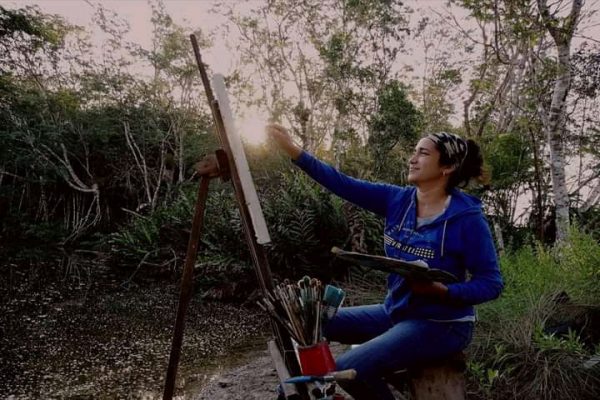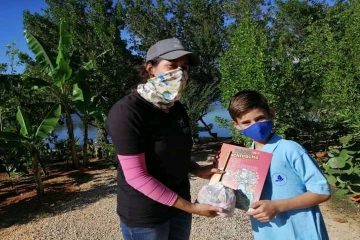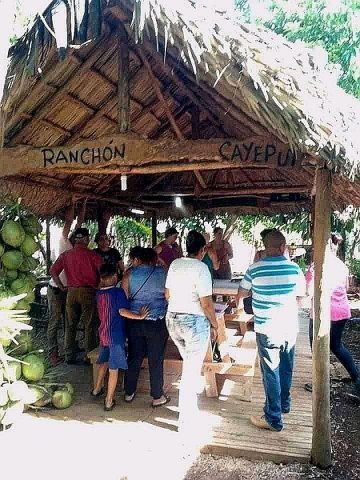Free Image, Art and Conservation in Cuba
A commitment to development that respects the environment

In the Cuban province of Matanzas, a project achieves its sustainability in harmony with the environment and using invasive forest species such as the marabou.
HAVANA TIMES – The Libre Imagen (free image), Art y Conservation workshop is an initiative that integrates the principles and practices of permaculture with art and popular education. It rescues the natural, historical and artistic values of the locality for the harmonious development of the community.
The project is located 174 kilometers from Havana, in Batey Mario Lopez, Playa Larga, Cienaga de Zapata. It is led by Susana Guevara Barrero, Visual Arts instructor, and Lazaro Ramon Sosa Morell, theater instructor.
Like many projects of this type, Libre Imagen also struggled with the search for a sustainable alternative. That is how they began to carry out carpentry and handicraft work using invasive wood species. They sell paintings and engravings that connect and re-signify natural, historical and artistic values of the area.
Guevara Barrero says the main goal of the project is to help develop the community, harmoniously integrated with the nature of the Cienaga de Zapata Biosphere Reserve.

Our vision is to revitalize the appreciation and creation of local aesthetic values for history, nature and art. In practice we integrate that vision and the goal in the work processes.
The carpentry and handicraft undertaking with woods of invasive and introduced species, such as the marabou (Dichrostachys cinérea), the cayeput (Melaleuca leucadendron L.), the casuarina (Casuarina equisetifolia) and the yarúa, (Caesalpinia cubensis) demonstrate this work ”, explains Guevara.
Invasive forest species displace local native and endemic plants occupying their living space. Profits from carpentry and wood crafts allow the project to logistically sustain environmental education processes in the community.
As caring for the environment is the most significant aspect for the Libre Imagen group, strategies are drawn up to gradually replace felled invasive trees with native species. To do this, they use methods based on the ethical principles of permaculture. Caring for the land and people, conserving the soil, forests and water, as well as the fair distribution of natural resources.
Ties with the community
The link with the community occurs through the project’s activity plan. People are integrated in workshops, as facilitators, listeners, managers, or workers. In addition to providing job opportunities and training, Libre Imagen assumes responsibility to promote female participation.
“In the Ciénaga de Zapata coexists a sort of association of women and men of science, biologists, bird watchers, geographers, ichthyofauna specialists, botanists, artists and teachers. For many years they have carried out research work in different ecosystems. They facilitate and pave the way towards a culture of conservation and sustainable development in the Cienaga de Zapata Biosphere Reserve,” notes Guevara.

Among the routine activities of Libre Imagen are the cleaning of the coastline, collecting solid waste, making wall paintings, oil paintings and acrylic on canvas, pyrography, painting, drawing, workshops and talks.
The dynamics slowed down with the pandemic and now include the design and preparation of interpretive signage for trails created by the Company for the Conservation of the Zapata Swamp (ECOCIENZAP). The project turns part of its promotional work to social networks, in order to spread and promote nature conservation.
A little history
Free Image, Art and Conservation emerged 14 years ago at the Nicolas Guillen Batista School of Art Instructors, in Camagüey, 540 kilometers from Havana. At that time it didn’t go by this name.
In its beginnings it aspired to become a children’s theater company, with elements of environmental education. Little by little, it focused on the environmentalist approach and the preparation of people from the community.
In the summer of 2015, with the help of the Cienaga de Zapata Community Transformations project, in collaboration with the Swiss NGO Zunzún and the headquarters of the Ministry of Science, Technology and Environment (CITMA) for Matanzas, they participated in collection of solid wastes on the coast.
They then developed training and teaching of agroecological tools to small groups of ornamental plant growers and artisans in the region.
“We received training in permaculture, project design and management, biodiversity and conservation, invasive species management, popular environmental education, solid waste management, sustainable tourism and environmental interpretation for local guides,” says Lazaro Sosa Morell. He describes this moment as the trigger to evolve the concept and name that Libre Imagen it has today.






Comments are closed.